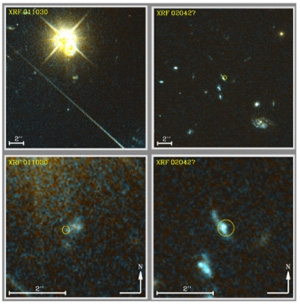Rosalba Perna and colleagues Jonathan Granot of Stanford and Enrico Ramirez-Ruiz of Princeton's Institute for Advanced Study recently figured out the relationship between X-ray flashes, X-ray rich gamma-ray bursts, and gamma-ray bursts detected by different space-based observatories. X-ray flashes are transient astronomical X-ray sources that last from several seconds to a few minutes. Their spectra are similar to both X-ray rich gamma-ray bursts and gamma-ray bursts. Gamma-ray bursts, which occur billions of light years from Earth, emit a hundred billion times more energy in a few seconds than our Sun produces in a year.
These luminous events signal the formation of a black hole resulting from the cataclysmic collapse of one of the massive stars formed during the early universe. X-ray rich gamma-ray bursts share characteristics with both gamma-ray bursts and X-ray flashes. All three phenomena are often associated with afterglows of light and other less energetic radiation.
To better understand the relationship among them, Perna and her associates studied the afterglows of specific X-ray flashes and X-ray rich gamma-ray bursts. They discovered that their light patterns were similar to those produced naturally by black holes emitting roughly uniform jets with relatively sharp edges—provided the jet was viewed from the side rather than head on. The researchers used the afterglow observations to support the hypothesis that gamma-ray bursts, X-ray rich gamma-ray bursts, and X-ray flashes emanate from similar structures and differ only in their orientation relative to our line of sight from Earth.
The paper reporting these findings was published online in February 2005 and has been accepted by the Astrophysical Journal. - Julie Phillips



 The Physics Frontiers Centers (PFC) program supports university-based centers and institutes where the collective efforts of a larger group of individuals can enable transformational advances in the most promising research areas. The program is designed to foster major breakthroughs at the intellectual frontiers of physics by providing needed resources such as combinations of talents, skills, disciplines, and/or specialized infrastructure, not usually available to individual investigators or small groups, in an environment in which the collective efforts of the larger group can be shown to be seminal to promoting significant progress in the science and the education of students. PFCs also include creative, substantive activities aimed at enhancing education, broadening participation of traditionally underrepresented groups, and outreach to the scientific community and general public.
The Physics Frontiers Centers (PFC) program supports university-based centers and institutes where the collective efforts of a larger group of individuals can enable transformational advances in the most promising research areas. The program is designed to foster major breakthroughs at the intellectual frontiers of physics by providing needed resources such as combinations of talents, skills, disciplines, and/or specialized infrastructure, not usually available to individual investigators or small groups, in an environment in which the collective efforts of the larger group can be shown to be seminal to promoting significant progress in the science and the education of students. PFCs also include creative, substantive activities aimed at enhancing education, broadening participation of traditionally underrepresented groups, and outreach to the scientific community and general public.